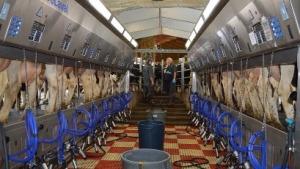Dairy in the World
Lameness could cost dairy farmers up to £13,600 a year in decreased milk yield

Despite being a top priority to reduce cases in UK herds, including industry initiatives such as "Lameness Month" this July, Wynnstay dairy specialist, Beth May, says lameness is still one of the highest costs to a dairy business.
“Cows with a locomotion score of 2 (mildly lame, walk arched) or 3 (moderately lame, stand arched) will produce 4 to 9% less milk than a non-lame cow1. This is roughly 1.5L/cow/day less. This is because a lame cow will stand more, eat less and ultimately have less energy left over for milk production,” explains Miss May.
“With the UK average running at 30% lame cows in the herd, this is equivalent to 48,500L less milk across a 200-cow herd (9,000L cows) and £13,600 PA in lost milk2. This is not considering the other long-term impacts lameness has on fertility, culling rate, number of replacements needed on-farm, additional labour, trimming and vet’s bills.”
For robotic herds, Miss May says it is even more critical to keep a close eye on early cases. Lame cows in a robotic system are likely to need fetching more for milking, so it will impact the average number of visits and therefore milk yield.
“As you don’t see the cows walking to the parlour on a daily basis, there’s less visual inspection of the cow’s mobility and hoof condition, making it more difficult to easily pick out cows for early treatment.
“To get on top of cases requires an early, proactive, preventative approach rather than reactionary cures.”
Miss Mays explains a few ways to keep cases at bay. “Consider monthly locomotion scoring or mobility scoring sessions with a ROMS accredited scorer to assess your current level of lameness and help pick out any cows for early treatment. We would advise recording at least 10% of the herd on a monthly basis, near the exit of the robot, so you can see them walk to a cubicle or feed fence. Furthermore, assessing in low pressure areas of the shed, such as loafing areas or wide passageways will allow you to assess cows walking freely and will give a more accurate record. Keep a track of results to monitor problem cows and those who may be borderline locomotion score 2.”
When it comes to trimming, Miss May notes this is only done because of overgrowth or trauma to hoof. “They’re only overgrown or damaged because something in the environment is not right,” she explains.
“This could be because of inadequate flooring, sharp corners and/or turns in sheds or the parlour, inappropriate cubicles impacting lying times or even inadequate nutrition. I would recommend working with an independent consultant to assess where the cause or problem areas are, and review where changes can be made in the short, medium and long-term. This could include alterations to floors with rubber matting or simple tweaks to rations.”
When it comes to nutrition, she notes that zinc has been proven to support hoof structure, to prevent lameness risk.
“Availa Zinc is the only proven performance mineral to reduce incidence of hoof lesions, such as digital dermatitis, ulcers or white line disease, by up to 30%. As well as lameness prevention, by supporting keratin production in the hoof, Availa Zinc is also proven to support against mastitis and reduce cell counts, due to its role in the formation of the keratin plug closing the teat canal after milking,” she adds.
“To stay on top of cases requires a proactive lameness management plan, taking into account all possible causes and quickly reacting with treatment to prevent the impact hitting the milk tank,” Miss May concludes.






















